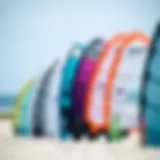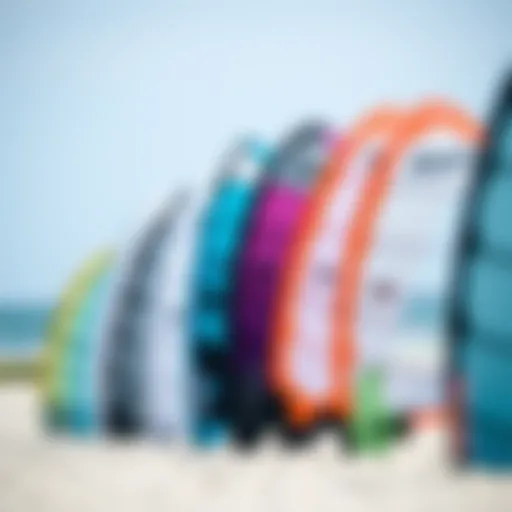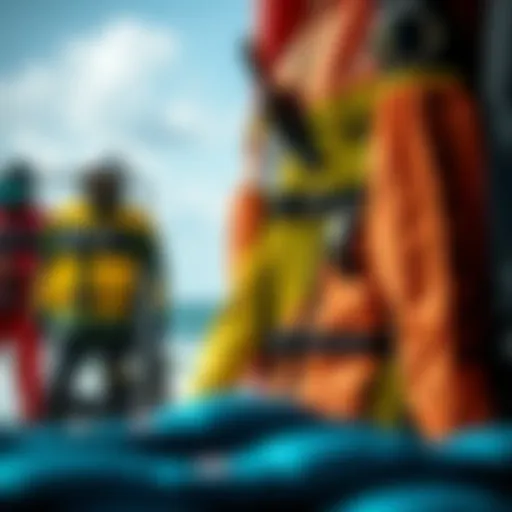Mastering Kiteboarding Techniques and Locations Guide
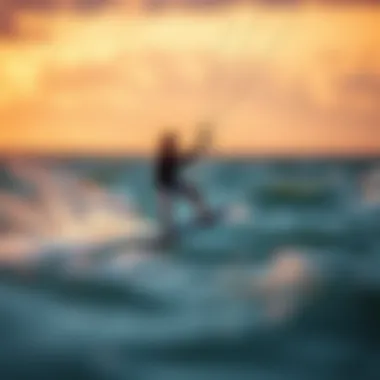
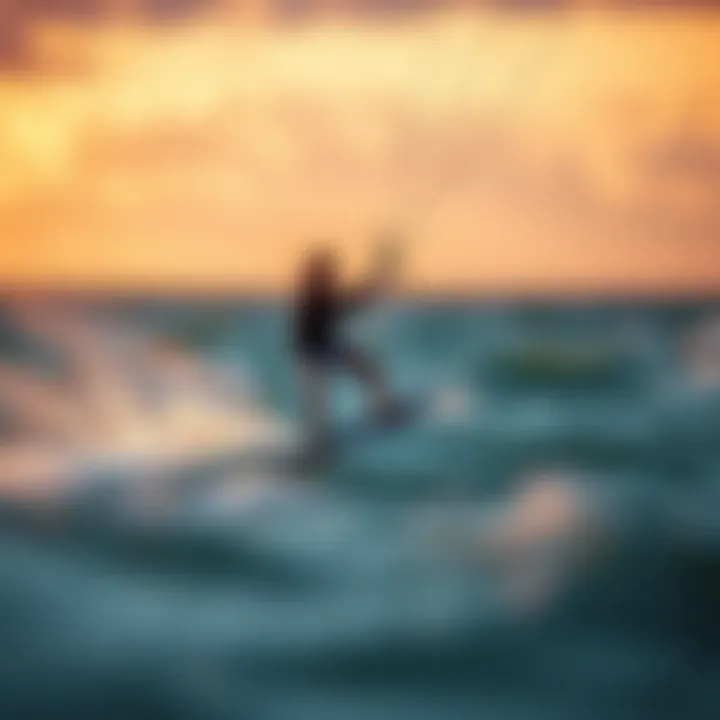
Intro
Kiteboarding, a thrilling blend of surfing and flying, has captivated water sports enthusiasts for years. This dynamic sport merges the power of the wind with the rush of riding the waves, creating an exhilarating experience. Every kiteboarder, whether a neophyte eager to catch their first ride or a seasoned pro looking to master the art of aerial tricks, finds the need to understand the nuances that come with it. The realm of kiteboarding isn't just about gliding across water; it's about harnessing skills, choosing the right equipment, and selecting the optimal location to enjoy the sport's full potential.
With the right techniques, solid equipment, and a strategic mindset, kiteboarding can transform from a mere hobby into a passion that’s hard to put down. This guide sets out to lay the groundwork for mastering kiteboarding, diving deep into essential techniques, offering evaluations of top gear, and showcasing the best locales to pursue this exhilarating sport.
Understanding the foundational aspects of kiteboarding promotes skill development and safety, ensuring that practitioners enjoy their time on the water while achieving their personal bests. Now, as we move through this guide, let’s kick off with the core techniques that can help kiteboarding enthusiasts, regardless of their experience level.
Techniques for Kiteboarding Enthusiasts
Kiteboarding is deeply rooted in technique. It’s not just about catching the wind but also about controlling it and learning how to manage your movements on water. Each level of capability brings its own set of techniques that can elevate the experience significantly.
Beginner Techniques
For those just stepping into the kiteboarding world, mastering the basics is crucial. Here are key techniques:
- Setup and Safety Checks: Before hitting the water, familiarise yourself with your gear. Ensure lines are tangle-free, knots are secure, and the kite is correctly set up.
- Body Drag: This exercise teaches control of the kite while being pulled through the water by it. It helps you get accustomed to the feel of the wind and how it reacts.
- Water Start: The pivotal moment each beginner looks forward to is getting up on the board. Focus on positioning your board correctly beneath you while pulling on the kite gently to stand.
Learning these techniques requires patience and practice, don’t rush it—there's no shortcut to mastery.
Advanced Maneuvers
Now that you can cruise, it’s time to jazz things up! Intermediate and advanced kiteboarders can try their hands at these remarkable moves:
- Jumping: After gaining confidence, you can practice how to launch off waves or use the kite to propel yourself into the air. Timing is everything; let the kite lift you right as you push off the board, and hold your body position steady.
- Downloops: This maneuver involves looping the kite through the air while jumping, resulting in impressive airtime and speed. Control and practice are vital as this can be tricky to execute without dropping the kite.
- Surfing Waves: For those who have experience, it can be exhilarating to ride waves, tweaking your performance according to water conditions. Balance and stability are crucial here.
Mastering advanced maneuvers often separates the wheat from the chaff in kiteboarding.
As you hone your skills, each successful endeavor breeds confidence, pushing you toward exciting new challenges on the water.
Equipment Reviews
Successful kiteboarding is greatly influenced by the quality and type of gear. The right equipment directly impacts your performance and overall enjoyment.
Kite Reviews
Choosing the right kite hinges on several factors including your skill level, the type of conditions you typically ride in, and personal preferences. Some noteworthy kites include:
- North Nexus: Renowned for its versatility, suitable for both freestyle and wave riding.
- Duotone Rebel: Offers excellent lift and hang time, and is great for jumping.
- Ozone Catalyst: A fantastic option for beginners with its forgiving nature and easy relaunch.
Board Reviews
Just like choosing the right kite, selecting a suitable board enhances your riding experience. Boards vary in size, shape, and material.
- Slingshot Misfit: Known for its great stability and comfort, perfect for various water conditions.
- Fanatic Sky: This model excels in wave riding, well-balanced and designed for performance.
- Naish Custom: Offers lightweight construction combined with durability, making it a favorite amongst serious riders.
As we explore each of these components and their role in kiteboarding, a clearer view of how to enhance one’s techniques emerges. Being informed about equipment not only aids in personal tilt but also enriches the kiteboarding community as a whole.
In the journey ahead, we will expand on locations, strategic insights, and how best to engage with this exhilarating sport. Dive in, the water's fine!
Preamble to Kiteboarding
Kiteboarding, an exhilarating blend of surfing, wakeboarding, and paragliding, has gained momentum as a favorite choice for water sports enthusiasts. This section lays the groundwork for understanding the nuances of the sport, shedding light on its historical roots, current trends, and the vibrant community that surrounds it.
Kiteboarding is more than just a hobby; it’s an art form that combines skill, technique, and a fair amount of adrenaline. From beginners grasping the basics to seasoned experts pushing the limits of what’s possible, this section serves as an essential primer. Launching into this guide will help delineate the inherent complexities and joyful aspects of kiteboarding.
Historical Context
Origins of the Sport
Kiteboarding traces back to the early days when kites were first used primarily for recreation and military purposes. Initially, the concept began to evolve in the late 1980s when enthusiasts started to attach surfboards to large kites—creating what we now recognize as kiteboarding. The unique feature of this origin is the blend of various disciplines, which contributes to its widespread appeal.
The advantage of understanding this history lies in recognizing how previous adaptations greatly influenced modern practices, offering insights into what makes kiteboarding an exciting prospect today.
Evolution of Techniques
As the sport developed, so did the techniques. Kiteboarding shifted from basic maneuvers to advanced tricks, driven by an ever-growing community eager to push boundaries. The introduction of streamlined kites and boards in the early 2000s changed the game dramatically. This evolution not only allowed riders to explore different riding styles but also made the sport more accessible.
Emphasizing this evolution helps participants grasp how the techniques they practice today are informed by past innovations, illustrating that progress in kiteboarding continues to flourish.
Influential Figures
Throughout its history, kiteboarding has been shaped by various influential figures, such as Laird Hamilton and Robby Naish, who helped popularize the sport through their skills and charisma. These individuals brought attention and legitimacy to kiteboarding, fostering a sense of community among enthusiasts.
Highlighting these figures and their contributions enriches the fabric of the sport, giving aspiring kiteboarders role models to look up to as they embark on their journey.
Current Popularity
Growth Trends
Kiteboarding has seen an undeniable rise in popularity over the years. Regions that previously had little to do with water sports now host thriving kiteboarding communities. Social media plays a huge role, as stunning visuals and sensational tricks captivate a wider audience, bridging the gap between enthusiasts and newcomers.
Understanding these growth trends is vital for anyone invested in the sport. It reveals market opportunities and social dynamics that could influence personal or professional trajectories within the kiteboarding realm.
Demographics of Participants
The demographics of kiteboarding participants have shifted considerably. Originally dominated by a specific age group, the sport has widened its reach to include a diverse cross-section of ages, genders, and backgrounds. This inclusivity is one of kiteboarding's shining attributes, showcasing that anyone drawn to the wind and waves can find their footing in this thrilling adventure.
This broad participation can be beneficial, as it leads to a more enriched community and a variety of perspectives that only enhance the sport.
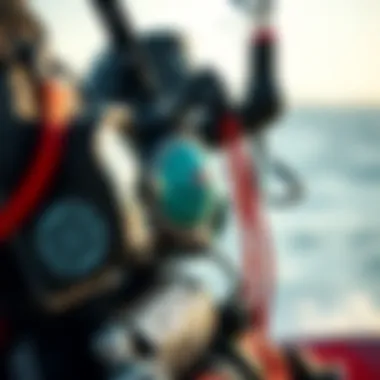
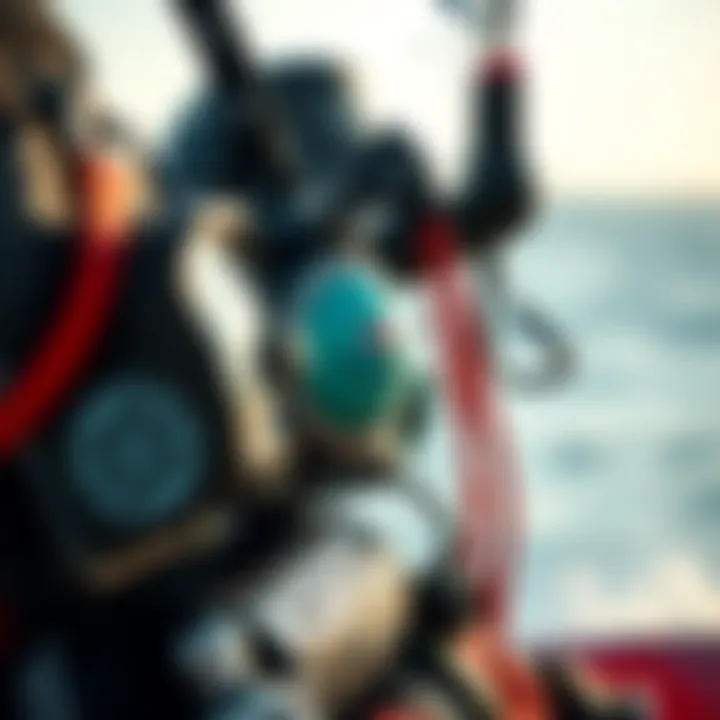
Global Events and Competitions
Major global events, such as the Kitesurf World Cup, showcase the top talent across the globe and foster community engagement. These competitions not only highlight cutting-edge skills but also offer a platform for kiteboarders to connect and share their passion.
Recognizing the significance of these events enhances one’s understanding of kiteboarding culture and promotes engagement within the community, making it easier for aspiring riders to find their place in this vibrant world.
Fundamental Techniques
Kiteboarding isn’t just about flying a kite; it’s a comprehensive sport that demands a grasp of various techniques. Fundamental techniques are the building blocks that allow kiteboarders to navigate and master the water effectively. A solid grounding in these techniques ensures not just safety, but also enhances the enjoyment and progression within the sport. Understanding the basics provides a essential framework, enabling participants to take on advanced maneuvers with greater ease.
Basic Maneuvers
Launching and Landing
The act of launching and landing a kite is fundamental in kiteboarding, serving as the initial step that sets the tone for the entire session. Key characteristics lie in mastering the wind patterns and understanding the kite’s response to input. This aspect greatly contributes to overall safety—an essential part of kiteboarding. Strong launches mean smoother beginnings and reduced chances for accidents.
One of the unique features of launching and landing is the controlled environment they create. Practicing these techniques prepares riders for various wind conditions that may arise in actual riding situations. However, neglecting this fundamental can lead to disastrous mishaps, particularly in gusty wind areas. Hence, safe and effective launching and landing practices are beneficial choices for any kiteboarding session.
Steady Riding
Achieving a state of steady riding involves maintaining balance and rhythm while maneuvering the kite through the wind. This technique is crucial as it facilitates a comfortable riding experience. The key characteristic of steady riding refers to fluidity and consistent speed; it should feel like second nature after some practice. It contributes to an enhanced sense of control and can significantly affect a rider's confidence level.
A unique part of achieving this steady riding is developing muscle memory. This characteristic can only come with time and consistent practice, but once it clicks, the advantages are vast. However, the downside is that inconsistent practice can make it challenging to develop this skill fully. Riders may find themselves swaying off balance or losing speed due to poor technique.
Turning Techniques
Turning techniques are more than just about direction; they represent the riders' ability to adapt and maneuver in varying conditions. The key characteristic of effective turning revolves around timing and weight distribution, which are vital for maintaining speed and flow. Mastering these moves is a beneficial choice for kiteboarders looking to develop their skills further.
A standout feature of turning techniques is the dynamic nature involved. Riders who can turn efficiently can adapt more easily to sudden changes in wind direction or water conditions. The advantage of mastering turns is that it allows one to keep the kite in the power zone longer, enhancing control. However, learning effective turns takes time, and many beginners find themselves struggling initially, making frustration a common hurdle in their journey.
Advanced Skills
Jumping and Tricks
Jumping and tricks represent an exciting leap in progression for kiteboarders. The thrill of soaring through the air is unmatched and attracts enthusiasts to push their limits. The key aspect of jumping involves timing—knowing when to pull on the bar and how to use the kite’s power to gain lift. This technique contributes significantly to showcasing a rider's skill level, making it a popular choice among kiteboarders.
Unique features such as different jumping styles (e.g., hooked in versus unhooked) add an element of creativity to this aspect of the sport. The advantages of mastering jumps include improved skills and the satisfaction that comes with successfully completing exciting maneuvers. On the flip side, the risks associated with jumping higher can be daunting, especially for beginners learning to control their landings.
Wave Riding
Wave riding is an art in itself, where the wind and water come together to create a unique experience. The primary focus is harnessing ocean swells, offering not just thrills but also a deeper connection with the environment. Key characteristics of wave riding highlight skillful navigation of waves, requiring an understanding of swell direction and water dynamics.
This technique contributes significantly to the evolution of a kiteboarding enthusiast. The immersive experience in nature fosters a bond that goes beyond just the sport itself. A unique aspect of wave riding lies in its ability to enhance agility and responsiveness. However, it also demands a high level of skill, and navigating waves can be challenging, often daunting for less experienced kiteboarders.
Freestyle Techniques
Freestyle techniques focus on individual expression, allowing riders to perform unique maneuvers that blend style and complexity. Key characteristics include creativity, as freestyle maneuvers can range from spins to flips, showcasing personal flair. This aspect is particularly exciting as it encourages kiteboarders to push beyond standard movements.
The contribution of freestyle to kiteboarding is significant; it nurtures an environment of innovation and personal mentoring. The unique feature of freestyle is the extensive array of tricks available, presenting countless opportunities for progression and personal growth. However, the challenge remains—freestyle techniques require practice and confidence, posing a steep learning curve that may deter some from fully embracing this thrilling side of kiteboarding.
Equipment Analysis
Understanding the equipment for kiteboarding is crucial. Proper gear not only enhances performance but also significantly affects safety. Each component—the kite, board, bindings, and safety gear—plays a pivotal role in ensuring that the kiteboarder can enjoy the sport without compromise. This section will explore the kites, the boards, their gear, and the other associated components. By breaking down these elements, we can appreciate how they contribute to overall kiteboarding proficiency.
Kites Overview
Types of Kites
Several types of kites exist, each crafted for specific conditions and rider styles. The main ones are:
- Inflatable Kites: Known for their durability and versatility, inflatable kites are a widely chosen option. They provide excellent lift and stability, making them perfect for beginners and experienced riders alike. The unique feature of these kites is their enclosed air chambers, giving them structure even when the wind isn't blowing strong. However, they can be cumbersome to transport due to their size.
- Foil Kites: These kites are lightweight and can be packed down to a much smaller size, but they require more skill to handle. Foil kites, with their soft construction, can stretch the limits of creativity in tricks and maneuvers. Yet, without solid wind conditions, their performance can dwindle compared to inflatable models.
Each kite type has a specific application that can enhance or limit a rider's capabilities based on conditions and personal preference.
Size Considerations
Size is not just a technical detail; it can make or break a session on the water. Kites come in varying sizes, and choosing the right one is essential for optimal performance. The key characteristic here relates to wind conditions. A large kite can harness more wind, allowing for higher jumps. Conversely, a smaller kite works better in stronger winds, providing more control.
A unique feature of size considerations is that a kite that’s too big can lead to overwhelming power, while one that’s too small might leave a rider underwhelmed. Just like trying to navigate without a compass, getting the size wrong leads to frustration.
Material Selection
The materials used for kites can affect their performance, longevity, and handling. High-quality materials such as ripstop nylon and polyester are common due to their strength and lightweight properties. Their key characteristic is the balance they offer between durability and flexibility.
Material selection contributes significantly to kite performance in various conditions. For instance, kites made from lower-quality materials might save money upfront but usually result in a more catastrophic failure during use. A unique feature to note is how some kites are reinforced in high-stress areas, setting them apart in terms of durability. These choices often dictate both initial performance and long-term investment success.
Boards and Gear
Board Types
The board you choose can significantly influence your kiteboarding journey. There are primarily two types of boards:
- Twin-Tip Boards: These boards are symmetrical, allowing for riding in either direction. They're popular among beginners because they ease learning and transitions. However, their flat bottom can make it challenging to perform high-speed maneuvers.
- Directional Boards: These boards are designed for riding in one direction. They're often favored for wave riding and provide more grip in rougher waters. The unique design means they can handle bigger waves, but this could make them less user-friendly for those just starting.
The choice between board types often comes down to individual riding styles and conditions.
Footstraps and Bindings
Footstraps and bindings are essential for comfort and stability. Footstraps are adjustable straps that secure the rider's feet to the board. The flexibility in how they can be customized makes them beneficial across different skill levels. They allow for easy entry and exit, which is critical during sessions.
Bindings, on the other hand, provide a more fixed option, holding the foot so that the rider feels more connected to the board. The tradeoff here can be the difficulty of getting into and out of the bindings when compared with footstraps.


Safety Equipment
Safety should always be at the forefront of every kiteboarding enthusiast’s mind. Proper safety equipment includes:
- Helmets: Protects the head from impact, especially in high-speed crashes.
- Impact Vests: These vests provide extra buoyancy and padding, crucial when falling or during impact.
- Leashes: Essential for keeping the kite attached to the rider and preventing runaway kites.
Investing in safety gear is a non-negotiable aspect of kiteboarding. While it may seem like an extra expense, these products are the first line of defense against injuries, offering peace of mind and allowing riders to focus on their skills.
Overall, analyzing kiteboarding equipment reveals layers of intricacies that can't be overlooked. Choosing the right kite, board, and safety gear lays the foundation for enhancing skills and enjoying the sport to its fullest extent.
Selecting Locations
Choosing the right location for kiteboarding is as crucial as mastering the techniques and picking the right equipment. The ambiance of a place, including its geographical features, can dramatically influence the kiteboarding experience. Factors like wind direction, water type, and local culture come into play, creating a rich tapestry of elements that define your ride. A suitable location doesn't just make for a pleasant time but can also be the difference between a fantastic session and a frustrating one.
Ideal Conditions
Wind Patterns
Wind patterns are the lifeblood of kiteboarding. Without adequate wind, your kite simply becomes a limp bag in the sky. Different locations exhibit distinct wind behaviors that can either be a boon or a bane. For instance, coastal areas often benefit from steady sea breezes during specific months, making them bedazzling spots for kiteboarders. In contrast, regions prone to gusty winds can become more challenging, necessitating experience and skill.
A key characteristic of favorable wind patterns is consistency. Capped with predictable winds often found in summer months, unique weather systems can also create strong thermal winds, such as those in Tarifa, Spain. However, wind patterns are not universally perfect; high winds can lead to choppy waters, affecting your ability to maintain control.
Water Conditions
Water conditions significantly contribute to the kiteboarding experience. Whether you'll be carving through flat water or tackling waves directly impacts your approach to the sport. Flat water areas, often found in lagoons, allow for easier control and can be perfect for beginners, whereas wave-riding locations require surfer-like skills and stamina.
What stands out in various water conditions is their versatility. Shallow waters are safer for beginners, making them a preferable option when learning the ropes. Nevertheless, deeper waters present challenges where tides and currents can turn even experienced riders around, sometimes leading to dangerous situations if one isn't careful enough.
Safety Assessments
Conducting safety assessments is all about being smart before taking to the water. This means weighing potential hazards, knowing the area, and preparing accordingly. Assessing safety isn't just about avoiding risks in water but also includes understanding local regulations—thereby ensuring you avoid interference with marine life and other water users.
A strong point in implementing robust safety assessments is their preventive nature. Before heading out, knowing the locations of hazards, like rocks or shallow depths, can save you grief. On top of that, being aware of what to do in an emergency, such as having a first aid kit and knowing how to signal for help, stands to enhance your overall experience.
Top Kiteboarding Destinations
Global Highlights
With locations ranging from sandy beaches to rugged coastlines, the world is replete with top kiteboarding destinations. Each place has its own charm, offering unique kiteboarding experiences. For example, Brazil's Praia do Preá is famed for its warm winds and excellent conditions throughout the year, whereas Maui presents showcases of various levels with powerful waves that can enthrall even veteran boarders.
What sets these locations apart is not just their scenery but also their consistent weather patterns. Many areas become hotspots during certain seasons, driving kiteboarding communities to swell. Notably, these global highlights often cater to a diverse range of expertise, making them approachable for anyone willing to take the plunge.
Why Location Matters
Location can make or break your kiteboarding journey. Factors such as accessibility, infrastructure, and community support play pivotal roles. If a spot is too remote or lacks amenities—like nearby accommodations or services—it might not be an attractive option, despite its beauty.
A fine example is the kiteboarding scene in Cape Town, known for both its vibrant local scene and its reliable winds, offering something for riders of all skill levels. Importantly, the atmosphere around kiteboarding spots can help bring the community together, creating bonds that stretch beyond watersports.
Local Culture and Community
The local culture surrounding kiteboarding destinations often enriches the experience in ways that mere geographical features cannot. Communities form around shared interests, bringing together enthusiasts who can share advice, tips, and camaraderie. In places like Cabarete on the Dominican Republic's north coast, the laid-back atmosphere attracts kiteboarders from all walks of life, leading to dynamic exchanges and friendships.
Connecting with the local community not only enhances enjoyment but also provides critical insights about the area that only locals would know. Engaging with seasoned riders can open doors to hidden gems, be they lesser-known spots or local events aimed at improving your skills.
In summary, selecting locations is not just a matter of finding a pretty place; it involves a thoughtful evaluation of wind and water conditions, safety assessments, and the local culture and community that play significant roles in creating an enriching kiteboarding experience.
Skill Development Strategies
When diving into the world of kiteboarding, skill development stands as an essential component that separates the novices from the experts. It’s not just about jumping on the board and catching the wind; a structured approach to honing skills enhances not only performance but also safety and enjoyment. With countless variables at play, focusing on specific strategies can yield significant improvements.
Training Plans
Consistency and Practice
Consistency and practice are like the backbone of any skill development strategy. Engaging in regular sessions leads to muscle memory, allowing movements to become second nature. Those who practice consistently find their confidence growing with each ride. The key characteristic here is the regularity and frequency of practice. It’s often said that a few sessions weekly beats a marathon practice once a month. The unique feature of consistency is its cumulative effect over time. However, without focus during practice, one might end up reinforcing bad habits. Therefore, it’s not merely about putting in the time; it’s about making every session count.
Goal Setting
Establishing clear goals is another pillar in the journey of skill development. Goals guide the trajectory of practice sessions and provide motivation. Whether aiming to master a trick or simply improve overall riding technique, having a specific target can increase dedication and focus. A key characteristic of goal setting is its ability to offer quantifiable measures of progress. Unlike vague aspirations, specific milestones can be tracked easily. The challenge, however, lies in balancing ambition with realism. Setting the bar too high can lead to frustration. Thus, breaking down larger aspirations into smaller, manageable tasks results in a more productive engagement with the sport.
Performance Analysis
Performance analysis involves reviewing one's riding sessions critically. This aspect is crucial because, without feedback, improvement can be a shot in the dark. Riders can utilize video recordings or even self-assess post-session to identify areas for improvement. The cornerstone of performance analysis is reflection. It allows for the recognition of strengths and weaknesses. A unique feature here is the utility of technology; apps and software can track progress, making data-driven decisions easier. However, relying solely on technology without personal reflection can lead to a disconnection from learning. A harmonious blend of personal insight and technical metrics usually fosters the best growth.
Online Resources and Communities
Educational Platforms
Educational platforms play a vital role in the skill development of kiteboarders. These platforms offer structured courses, instructional videos, and tutorials designed to improve technique and understanding of the sport. The key characteristic here is accessibility. Whether you're at home or on a trip, resources are just a click away. A unique feature is the breadth of content available, covering everything from beginner basics to advanced maneuvers. Nevertheless, the quality can vary. Choosing reputable sites prevents misinformation and ensures effective learning.
Forums and Social Media
Forums and social media outlets offer a space for kiteboarders to connect, share experiences, and seek advice. The community aspect is invaluable; it provides support and motivation from fellow enthusiasts. Important characteristics of these platforms include the instant feedback and diverse perspectives one can gain. This peer-to-peer interaction can greatly enhance the learning experience. However, it can also lead to misinformation spreading, so users should approach advice with a critical mindset and verify facts where possible.
Networking with Other Enthusiasts
Networking creates opportunities to learn directly from more experienced kiteboarders. Local meetups, events, or online groups can facilitate connections. The beauty of networking is that it opens avenues for collaborative learning; riding with others often leads to knowledge exchange and skill sharing. A distinguishing feature is the camaraderie that forms, pushing everyone to improve while enjoying the sport. Unfortunately, it can sometimes lead to competitive pressures that may overwhelm newcomers. Finding a balance between competition and enjoyment is essential to truly benefit from networking.
Safety Considerations
Safety is paramount in kiteboarding, as it directly influences not only individual well-being but also the collective enjoyment of the sport. Understanding potential risks, establishing emergency protocols, and adhering to local regulations is essential for anyone wishing to engage in this thrilling activity. These are not mere afterthoughts; they are critical components that ensure a safe and enjoyable kiteboarding experience for participants of all skill levels.
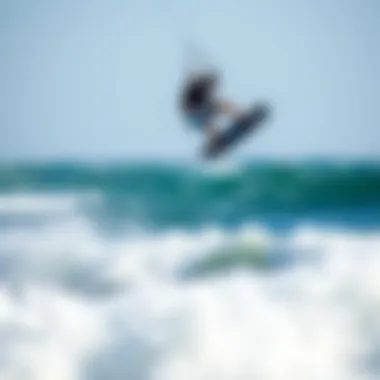
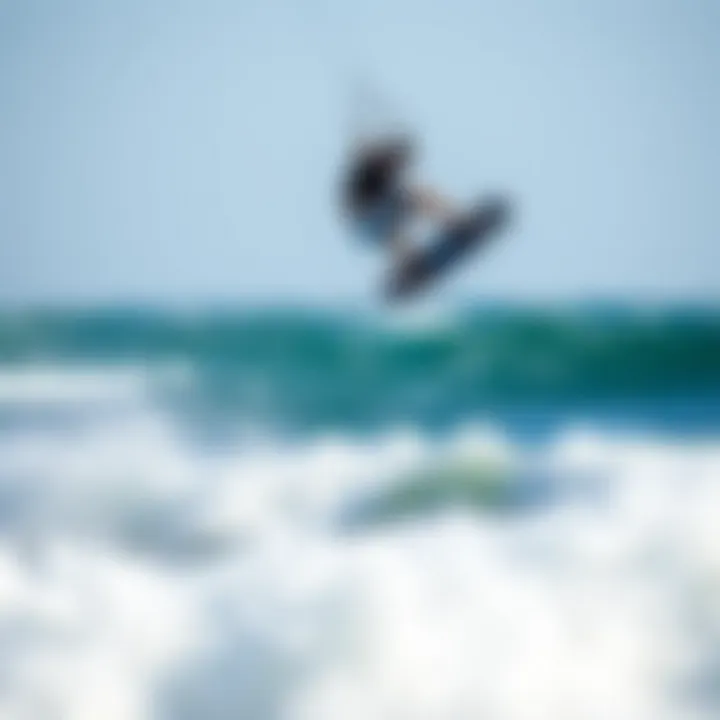
Risk Management
Understanding Hazards
Kiteboarding, while exhilarating, comes with its own set of hazards. Understanding these involves recognizing both environmental conditions and equipment-related risks. The wind is a significant factor; it can change in an instant. Surfers should be aware of wind speed and direction, as gusty winds can make riding challenging, if not dangerous. Moreover, proximity to obstacles like buildings, boats, or other kiteboarders can lead to dangerous situations.
The key element of understanding hazards is awareness. Recognizing how conditions can impact performance and safety is crucial. For beginners, a beneficial choice is to always ride in areas designated for kiteboarding. These spots often have clearer safety protocols and ensure a supportive environment. The unique feature of this awareness lies in its ability to enhance decision-making skills while on the water, allowing riders to adapt in real time to changing conditions.
Emergency Preparedness
Emergency preparedness is about having a plan in place before something goes wrong. Kiteboarders should familiarize themselves with emergency protocols, such as how to contact local rescue services when needed. This knowledge doesn't just prepare one for unfortunate events; it can also provide peace of mind while out on the water.
Having emergency equipment, like a whistle or a flare, is a key aspect of preparedness. It showcases a responsible approach towards potential incidents. It might feel over the top, but it's an essential measure that can make the difference in critical moments.
Being ready for emergencies means you won’t be caught flatfooted, significantly reducing the chances of panic, which can exacerbate a situation.
First Aid Knowledge
First aid knowledge is another crucial aspect of kiteboarding safety. Having basic first aid skills may not seem directly relevant to riding, but accidents can hapen to anyone, anywhere. Understanding how to bandage a wound or perform CPR can be lifesaving.
The main characteristic that makes first aid knowledge vital is its universal applicability; it's a skill that benefits everyone in a group setting. Plus, in a water sport like kiteboarding, where injuries might occur due to falls or equipment failure, knowing the basics can enable prompt action that could prevent complications.
That knowledge can also enhance communication and coordination within a group. In the heat of the moment, someone knowledgeable in first aid can take charge, directing others and making quick decisions.
Regulatory Compliance
Local Regulations
Every area may have different regulations regarding kiteboarding, and being informed about these rules is essential. Local regulations can include designated kiteboarding zones, restrictions on times of operation, and specific safety gear requirements. Adhering to these can lessen the likelihood of accidents and improve relationships with other water users.
Understanding local laws not only fosters a respectful use of shared spaces, but it also helps kiteboarders navigate potential legal hurdles. For instance, ignoring regulations could lead to fines or even getting banned from certain locations.
Permits and Rights of Way
Navigating the legal landscape often includes understanding permits and rights of way. Some regions may require specific permits for kiteboarding, particularly in popular locations. This highlights the importance of doing your homework before heading out to the water. It may sound like a hassle, but gaining the necessary permissions ensures a respectful and compliant experience for all.
Once the paperwork is in order, kiteboarders can focus on what really matters—riding the waves and enjoying the adventure—without the nagging concern of legal repercussions looming overhead.
Environmental Concerns
Environmental concerns are increasingly significant in sports like kiteboarding. Being mindful of marine life, coastal ecosystems, and other natural elements not only preserves these environments for future enjoyment but also demonstrates responsible behavior that can influence broader community acceptance.
A key element of awareness in this context is how kiteboarders can be advocates for the environment. By adhering to eco-friendly practices, such as avoiding sensitive areas during nesting seasons or choosing biodegradable gear, the kiteboarding community can manage its impact on the environment.
In summary, each aspect of safety considered here—risk management, regulatory compliance, and environmental responsibility—intertwines to create a framework that supports safer kiteboarding experiences. Passion for this sport should blend seamlessly with the consciousness of safety and respect towards both fellow riders and nature.
Future of Kiteboarding
The future of kiteboarding is a fascinating intersection of technology, emerging markets, and evolving demographics. Understanding this landscape is crucial for anyone interested in the sport, as it shapes how kiteboarding is practiced, perceived, and enjoyed around the world. The advancements that come with new technology not only enhance performance but also influence the accessibility of kiteboarding for newcomers. Moreover, recognizing the changing markets and demographics helps in anticipating who will participate in the sport in the years to come. Evaluating sustainability initiatives further emphasizes kiteboarding's alignment with environmental consciousness, ensuring the sport's longevity.
Technological Advances
Smart Equipment
Smart equipment in kiteboarding has taken the sport to new heights, literally. Kites equipped with GPS tracking and performance analytics provide riders with feedback, allowing them to fine-tune their skills effectively. One of the standout features of smart kites is their ability to adjust to wind conditions automatically. This ensures that not only is performance optimized, but safety is also prioritized. Riders can now push their limits with confidence, knowing that their gear is equipped to handle unexpected changes in wind speed or direction. The downside, however, is that this reliance on technology may lead to a disconnection from the traditional aspects of kiteboarding, potentially making it less appealing to purists.
Materials Innovation
As kiteboarding evolves, so does the technology surrounding the materials used. Lighter yet stronger materials are revolutionizing kite design, allowing for an exciting fusion of stability and agility. For instance, fabrics with improved durability can withstand harsher conditions, enhancing the kite’s lifespan. Riders often appreciate how these innovations lead to higher performance without significantly increasing weight. But this can lead to a higher price point, which may deter entry-level kiteboarders. Ultimately, materials innovation represents a commitment to improvement, ensuring that the sport remains engaging for both seasoned and rookie riders.
The Role of Drones
Drones are transforming the way kiteboarding is filmed and enjoyed. They offer unique aerial perspectives, capturing the beauty and thrill of the sport like never before. For many, having footage from a bird's-eye view provides a new dimension to sharing their experiences online. Importantly, drones enhance safety by providing real-time monitoring of conditions, alerting riders of any potential hazards in the vicinity. The downside may be privacy concerns from both land and water users, leading to regulatory challenges that future enthusiasts will likely have to navigate. Keeping these factors in check is crucial as we embrace this technological evolution.
Trends and Predictions
Emerging Markets
Emerging markets in kiteboarding are places where the sport is gaining traction, showing great potential for growth. Regions such as Southeast Asia, with its vast coastlines and favorable wind conditions, provide ripe environments to inspire new kiteboarders. The key characteristic of these markets is their diversity in landscapes, each offering unique riding experiences. Developing these areas further opens opportunities for locals to engage in water sports, promoting healthy lifestyles while boosting tourism. However, there’s the challenge of finding ways to ensure that local communities benefit equitably from this expansion.
Changing Demographics
Kiteboarding demographics are shifting as more diverse age groups and backgrounds take up the sport. The increasing interest among women and older adults marks a noteworthy trend in making kiteboarding more inclusive. The growth of community classes and social clubs encourages camaraderie and support among participants, making it easier for newcomers to feel welcomed. However, as demographics change, so does the need to promote safety and accessibility across all ages. Gear manufacturers and instructors must adapt to meet the diverse needs of this expanding audience.
Sustainability in Kiteboarding
Sustainability in kiteboarding is becoming increasingly critical as enthusiasts become aware of their environmental impact. By adopting eco-friendly practices—like using sustainable materials for gear and participating in local clean-up events—kiteboarders can contribute to preserving natural settings. The focus on sustainable equipment also reflects the industry's commitment to protecting coastal ecosystems while maintaining the thrill of the sport. However, promoting sustainability requires continuous dialogue and collaboration within the kiteboarding community to ensure that efforts are both effective and meaningful.
In summary, the future of kiteboarding holds exciting possibilities shaped by technological advancements, emerging markets, changing demographics, and sustainable practices. As the sport continues to evolve, the kiteboarding community must embrace these changes while remaining true to its roots.
Culmination
The conclusion of this article emphasizes the significance of mastering kiteboarding not just as a sport, but as an exhilarating lifestyle choice. Throughout the sections, we’ve explored various facets that contribute to a comprehensive understanding of this dynamic activity. From the historical roots and techniques to safety precautions and technological advances, each element plays a crucial role in shaping the kiteboarding experience.
A strong grasp of fundamental skills turns novices into proficient riders, while advanced techniques elevate even seasoned kiteboarders to new heights. The insights into equipment choices help riders select the right gear that fits their individual style and preferences. Furthermore, knowing the ideal locations for kiteboarding can significantly enhance the enjoyment and safety of every session, making it about more than just adrenaline—it's about the whole experience.
The benefits of becoming well-versed in these areas not only affect personal performance but also contribute to a respectful and aware community of kiteboarding enthusiasts. Understanding regulations and environmental concerns ensures that the sport can thrive for generations to come, without causing harm to its natural surroundings.
Recap of Key Points
- Historical Context: Acknowledge the origins and evolution of kiteboarding, noting how influential figures shaped the sport into its modern form.
- Fundamental Techniques: Mastering basic maneuvering and advancing skills is essential for both safety and skill enhancement.
- Equipment Knowledge: Understanding the types of kites and boards, along with their materials and sizes, influences performance greatly.
- Location Selection: Ideal surfing conditions, local culture, and community engagement make choosing the right spot paramount.
- Skill Development Resources: Utilizing training plans and online communities can accelerate learning and improvement among kiteboarders.
- Safety Practices: Recognizing hazards and knowing emergency procedures can mitigate risks greatly and ensure a safer experience.
- Future Considerations: Keeping an eye on technological advancements and sustainability efforts will keep the sport relevant and enjoyable for all.
Final Thoughts
In summary, kiteboarding is not just about the wind in your face and the thrill of riding waves—it's an intricate blend of skill, knowledge, and respect for the environment. As you delve deeper into your kiteboarding journey, remember that mastery comes from practice and continuous learning. Engage with the community, share experiences, and never hesitate to seek out new information. Whether you're catching air on a jump, or simply enjoying a leisurely ride, the world of kiteboarding has much to offer.
Consider connecting with fellow kiteboarders through platforms like reddit.com or facebook.com, where ideas and experiences are readily shared. Ultimately, the journey of mastering kiteboarding is yours to explore; embrace the lessons, the waves, and the winds that propel you forward.








